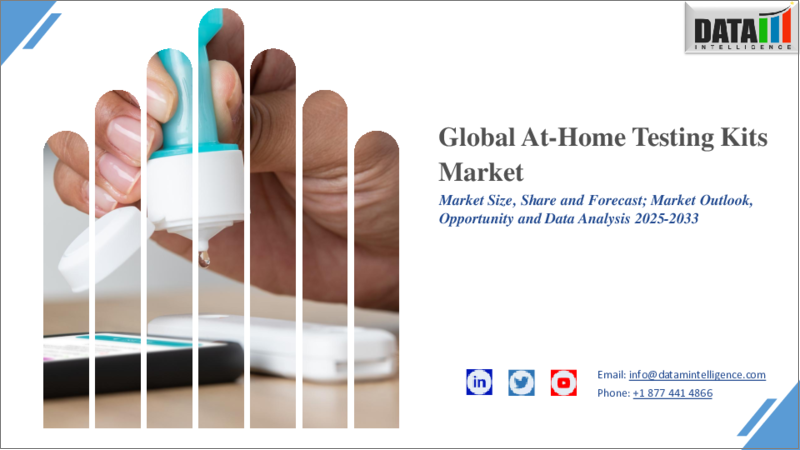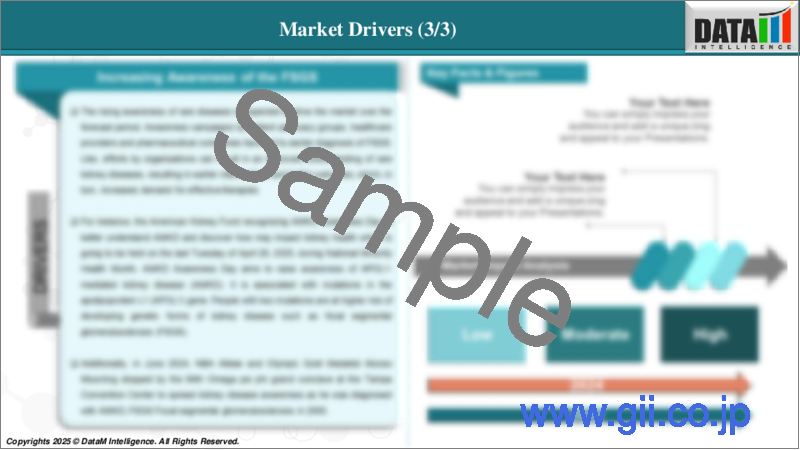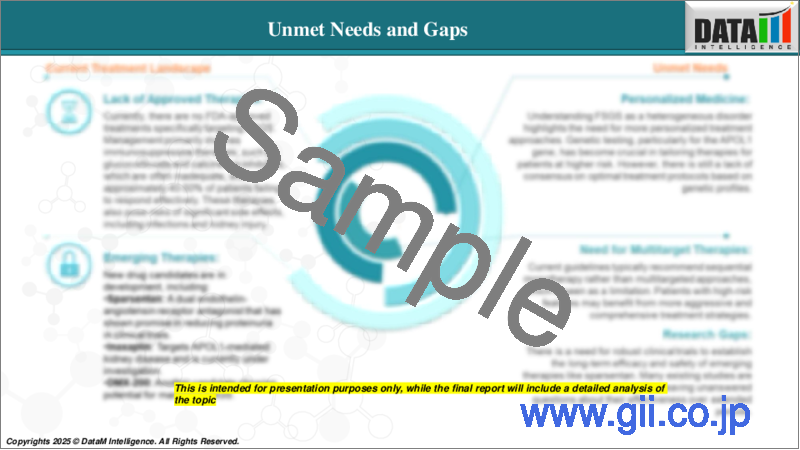|
|
市場調査レポート
商品コード
1643901
家庭用検査キットの世界市場(2025年~2033年)Global At-home Testing Kits Market - 2025-2033 |
||||||
カスタマイズ可能
適宜更新あり
|
|||||||
| 家庭用検査キットの世界市場(2025年~2033年) |
|
出版日: 2025年01月27日
発行: DataM Intelligence
ページ情報: 英文 200 Pages
納期: 即日から翌営業日
|
- 全表示
- 概要
- 目次
世界の家庭用検査キットの市場規模は、2024年に95億3,000万米ドルに達し、2033年には172億5,000万米ドルに達すると予測され、予測期間2025年~2033年のCAGRは7.1%で成長する見通しです。
家庭用検査キットは、家庭用診断キットとしても知られ、自宅に居ながらにして多くの健康上の懸念事項に対する特定の検査やスクリーニングを実施できる医療用品です。これらのキットには一般的に、必要不可欠な道具、包括的な説明書、検査を行う場所にサンプルを送るための元払い梱包がすべて含まれています。これらのキットを使えば、ヘルスケア施設に行かなくても、簡単で秘密厳守の健康チェックができます。
技術の進歩は、予測期間中の世界の家庭用検査キット市場を牽引する要因です。例えば、MasimoはMightySat MedicalがFDA認可を取得したと発表し、処方箋なしで入手できる最初で唯一のFDA認可医療用指先パルスオキシメータとなりました。この認可により、ユーザーはMasimo SETパルスオキシメトリを搭載したパルスオキシメータ医療機器を手に入れることができます。技術の進歩は検査手順を簡単で効率的なものにし、人々はこれらの検査キットにシフトしているため、需要が増加し、世界の家庭用検査キット市場を牽引しています。
市場力学:
促進要因と抑制要因
技術的進歩
技術の進歩は、世界の家庭用検査キット市場の成長において重要な要因となることが予想されます。ヘルスケアの進化に伴い、迅速かつ正確で、簡単にアクセスできる診断ソリューションへの需要が高まっています。バイオセンサー、マイクロ流体工学、ラボオンチップシステムなど数多くの技術進歩が診断を改善し、より効率的で信頼性の高いものにしています。例えば、2024年9月、アボット・ラボラトリーズは、米国で市販の持続グルコース・モニターであるLingoの発売を発表しました。アボットの重要な目的のひとつは、血流中の糖の量が突然上昇し、その後減少するときに起こるグルコース・スパイクをLingoのユーザーに通知することです。
さらに、DEXISは2024年8月、DEXIS CBCTおよび口腔内センサー装置用の新しいプロアクティブ・サービス・プラットフォームであるDEXIS Connect Proを開始しました。この専用プラットフォームは、モノのインターネット(IoT)技術を利用してこれらの機器の状態を継続的に監視し、機器が最適に機能するようにします。DEXIS Connect Proは、潜在的な問題を自動的に特定し、必要に応じて支援や機器の交換をスケジューリングすることで、機器のアップタイムを大幅に向上させることを目的としています。技術の進歩により、検査手順がシンプルかつ効率的になり、人々はこれらの検査キットにシフトしているため、需要が増加し、世界の家庭用検査キット市場を牽引しています。
厳しい規制要件
厳しい規制要件などの要因が、家庭用検査キットの世界市場を抑制すると予想されます。これらのキットは医療機器に分類され、米国のFDAや他の国の同等の当局のような規制機関からの厳しい承認プロセスを経なければなりません。承認手続きには通常、検査結果が正確で信頼できるものであることを保証するための厳格な臨床バリデーションが含まれます。しかし、規制状況は地域によって大きく異なるため、市場環境は分断されています。この相違により、複数の地域で同時にライセンシングを受けようとする企業は、それぞれの地域に適した多様な規制の枠組み、文書化要件、臨床試験プロトコルを管理しなければならず、手続きが複雑になります。このような厳しい規制要件が、世界の家庭用検査キット市場の妨げとなっています。
目次
第1章 調査手法と調査範囲
第2章 定義と概要
第3章 エグゼクティブサマリー
第4章 市場力学
- 影響要因
- 促進要因
- 技術的進歩
- 抑制要因
- 厳格な規制要件
- 機会
- 影響分析
第5章 産業分析
- ポーターのファイブフォース分析
- サプライチェーン分析
- 価格分析
- 規制分析
- 償還分析
- 特許分析
- SWOT分析
- DMIの見解
第6章 製品タイプ別
- デジタル監視機器
- ストリップ
- テストパネル
- サンプル収集キット
- その他
第7章 用途別
- 血糖値検査
- 妊娠と不妊検査
- がん検査
- 薬物乱用検査
- コレステロール検査
- その他
第8章 サンプル別
- 尿
- 血液
- 唾液
- 膣スワブ
- その他
第9章 流通チャネル別
- 院内薬局
- 小売薬局
- オンライン薬局
第10章 地域別
- 北米
- 米国
- カナダ
- メキシコ
- 欧州
- ドイツ
- 英国
- フランス
- スペイン
- イタリア
- その他欧州
- 南米
- ブラジル
- アルゼンチン
- その他南米
- アジア太平洋
- 中国
- インド
- 日本
- 韓国
- その他アジア太平洋
- 中東・アフリカ
第11章 競合情勢
- 競合シナリオ
- 市況・シェア分析
- M&A分析
第12章 企業プロファイル
- Abbott
- 会社概要
- 製品ポートフォリオと概要
- 財務概要
- 主な発展
- F. Hoffmann-La Roche
- BD
- Siemens Healthcare Private Limited
- Bio-Rad Laboratories, Inc.
- Danaher Corporation
- SEKISUI Diagnostics
- Trinity Biotech
- Beckman Coulter, Inc.
- Nova Biomedical
第13章 付録
The Global At-home Testing Kits Market reached US$ 9.53 Billion in 2024 and is expected to reach US$ 17.25 Billion by 2033, growing at a CAGR of 7.1% during the forecast period 2025-2033.
At-home testing kits, also known as home test kits or home diagnostic kits, are medical supplies that enable people to perform particular tests or screenings for a number of health concerns from the comfort of their own homes. These kits generally include all essential tools, comprehensive instructions, and prepaid packaging for sending samples to the place where the examination is done. These kits give users a simple and confidential way to check their health without having to visit a healthcare facility.
Technological advancements are the driving factor that drives the global at-home testing kits market over the forecast period. For instance, Masimo announced that MightySat Medical received FDA clearance, making it the first and only FDA-cleared medical fingertip pulse oximeter available without a prescription. This clearance entitles users to a pulse oximeter medical device powered by Masimo SET pulse oximetry. The increasing technological advancements make the testing procedures simple and efficient, and people are shifting towards these testing kits, which increases the demand and drives the Global At-home testing kits market.
Market Dynamics: Drivers & Restraints
Technological advancements
Technological advancements are expected to be a significant factor in the growth of the global at-home testing kits market. As the healthcare sector evolves, there is a growing demand for rapid, accurate, and easily accessible diagnostic solutions. Numerous technological advancements, such as biosensors, microfluidics, and lab-on-a-chip systems, have improved diagnostics, making them more efficient and reliable. For instance, in September 2024, Abbott Laboratories announced the launch of Lingo, an over-the-counter continuous glucose monitor, in the United States. One of Abbott's key objectives is to notify Lingo users about glucose spikes, which occur when the quantity of sugar in the bloodstream suddenly rises and subsequently decreases.
Moreover, in August 2024, DEXIS launched DEXIS Connect Pro, a new proactive service platform for DEXIS CBCT and Intraoral Sensor Devices that focuses on increasing device uptime. This exclusive platform uses Internet of Things (IoT) technology to continuously monitor the health of these devices, ensuring they function optimally. DEXIS Connect Pro aims to greatly enhance device uptime by automatically identifying potential problems and scheduling assistance or equipment replacements as needed, which is critical for dental offices that rely on consistent functioning to deliver patient care. The increasing technological advancements make the testing procedures simple and efficient, and people are shifting towards these testing kits, which increases the demand and drives the Global At-home testing kits market.
Stringent regulatory requirements
Factors such as stringent regulatory requirements are expected to hamper the global at-home testing kits market. These kits are categorized as medical devices and must go through stringent approval processes from regulatory agencies like the FDA in the United States and equivalent authorities in other countries. The approval procedure usually includes rigorous clinical validation to ensure that the tests produce accurate and reliable results. However, the regulatory landscape differs significantly among regions, resulting in a fragmented market environment. This discrepancy complicates the procedure for companies seeking simultaneous licenses in several regions, as they must manage diverse regulatory frameworks, documentation requirements, and clinical trial protocols appropriate to each region. These stringent regulatory requirements hamper the global at-home testing kits market.
For more details on this report - Request for Sample
Segment Analysis
The Global At-home Testing Kits Market is segmented based on Product Type, Application, Sample, Distribution Channel, And Region.
Blood glucose testing segment is expected to dominate the global At-home testing kits market share.
Blood glucose testing is anticipated to dominate the global At-home Testing Kits market owing to increased diabetes prevalence, technological improvements, and an increase in demand for rapid diagnostic solutions. Diabetes remains a huge public health challenge around the world, thus effective management strategies are more important than ever. The increasing prevalence is one of the major reasons for the dominance of this segment. For instance, according to the National Institute of Health, approximately 462 million individuals were affected by type 2 diabetes corresponding to 6.28% of the world's population. The rising number of diabetes cases increases the need for blood glucose testing and it increases the demand for blood glucose testing devices making this segment the most dominant.
In recent times, there have been launches and FDA approvals of blood glucose testing devices. For instance, in September 2024, Abbott Laboratories announced that its over-the-counter continuous glucose monitor Lingo is available in the U.S. One of Abbott's primary goals is to help Lingo users learn about glucose spikes, which occur when the amount of sugar present in the bloodstream rapidly increases and then decreases. Technological advancements and an increasing number of diabetes among the population increase the demand for blood glucose testing, making this segment the most dominating in the global at-home testing kits market.
Geographical Analysis
North America is expected to hold a significant position in the global at-home testing kits market share.
North America will likely account for a significant share of the global at-home testing kits market, owing to strong healthcare infrastructure, rising incidence of chronic diseases, and technological improvements. The increased prevalence of chronic diseases, such as diabetes, cardiovascular problems, and infectious diseases, is a major driver of market expansion in North America. For instance, according to the Centers for Disease Control and Prevention, in 2024 more than 38 million Americans have diabetes (about 1 in 10), and about 90% to 95% of them have type 2 diabetes. Type 2 diabetes most often develops in people 45 or older, but more and more children, teens, and young adults are also developing it. This upsurge increases the need for quick and efficient diagnostics which increases the demand for at-home testing kits in this region.
There are recent launches in this region due to the presence of major players. For instance, in June 2024, Prevounce Health announced the launch of its first remote blood glucose monitoring device, Pylo GL1-LTE. The blood glucose meter has been scientifically tested and linked to numerous cellular networks to guarantee more dependable data transmission across the United States. The GL1-LTE is compatible with the Prevounce remote care management platform and may be integrated with other health software using the Pylo cloud API. Prevounce's Pylo cellular-connected devices include blood pressure monitors and weight scales. The technological advancements, make testing procedures easy and efficient and it increases the demand for the at-home testing kits and drives the market in this region.
Asia Pacific is growing at the fastest pace in the global at-home testing kits market.
The Asia Pacific region is emerging as the fastest-growing market for at-home testing kits, owing to rising healthcare funds, increased awareness of early disease diagnosis, the demand for quick and precise diagnostic results, and technological advancements. The need for at-home testing kits has increased as these kits have proven invaluable for the early diagnosis and monitoring of a variety of health disorders, thereby improving disease management results throughout the region.
There are recent launches of devices in this region making it the fastest-growing region. For instance, in September 2024, Mankind Pharma Ltd. announced the launch of its latest innovation, RAPID NEWS self-test kits, which are intended to address common health conditions such as dengue, urinary tract infections (UTIs), and early menopause. This launch is a significant step toward accessible healthcare, with the goal of providing citizens across India with convenient, confidential, and rapid testing alternatives. The increasing demand for at-home testing kits and the technological advancements drive the market in this region.
Competitive Landscape
The major global players in the global at-home testing kits market are Abbott, F. Hoffmann-La Roche, BD, Siemens Healthcare Private Limited, Bio-Rad Laboratories, Inc., Danaher Corporation, SEKISUI Diagnostics, Trinity Biotech, Beckman Coulter, Inc., Nova Biomedical among others.
Emerging Players
PocDoc, Biocode, Sense4Med among others
Key Developments
- In August 2024, The Dengue NS1 Antigen Self-Test is a proactive tool that detects the dengue NS1 antigen in patients as soon as symptoms occur. This early detection capability allows people to take charge of their health and seek urgent medical attention. The NS1 antigen can be found in both primary and subsequent dengue infections.
Why Purchase the Report?
- Pipeline & Innovations: Reviews ongoing clinical trials, and product pipelines, and forecasts upcoming advancements in medical devices and pharmaceuticals.
- Product Performance & Market Positioning: Analyzes product performance, market positioning, and growth potential to optimize strategies.
- Real-World Evidence: Integrates patient feedback and data into product development for improved outcomes.
- Physician Preferences & Health System Impact: Examines healthcare provider behaviors and the impact of health system mergers on adoption strategies.
- Market Updates & Industry Changes: Covers recent regulatory changes, new policies, and emerging technologies.
- Competitive Strategies: Analyzes competitor strategies, market share, and emerging players.
- Pricing & Market Access: Reviews pricing models, reimbursement trends, and market access strategies.
- Market Entry & Expansion: Identifies optimal strategies for entering new markets and partnerships.
- Regional Growth & Investment: Highlights high-growth regions and investment opportunities.
- Supply Chain Optimization: Assesses supply chain risks and distribution strategies for efficient product delivery.
- Sustainability & Regulatory Impact: Focuses on eco-friendly practices and evolving regulations in healthcare.
- Post-market Surveillance: Uses post-market data to enhance product safety and access.
- Pharmacoeconomics & Value-Based Pricing: Analyzes the shift to value-based pricing and data-driven decision-making in R&D.
The global at-home testing kits market report delivers a detailed analysis with 70+ key tables, more than 50+ visually impactful figures, and 200 pages of expert insights, providing a complete view of the market landscape.
Target Audience 2024
- Manufacturers: Pharmaceutical, Medical Device, Biotech Companies, Contract Manufacturers, Distributors, Hospitals.
- Regulatory & Policy: Compliance Officers, Government, Health Economists, Market Access Specialists.
- Technology & Innovation: AI/Robotics Providers, R&D Professionals, Clinical Trial Managers, Pharmacovigilance Experts.
- Investors: Healthcare Investors, Venture Fund Investors, Pharma Marketing & Sales.
- Consulting & Advisory: Healthcare Consultants, Industry Associations, Analysts.
- Supply Chain: Distribution and Supply Chain Managers.
- Consumers & Advocacy: Patients, Advocacy Groups, Insurance Companies.
- Academic & Research: Academic Institutions.
Table of Contents
1. Methodology and Scope
- 1.1. Research Methodology
- 1.2. Research Objective and Scope of the Report
2. Definition and Overview
3. Executive Summary
- 3.1. Snippet by Product Type
- 3.2. Snippet by Application
- 3.3. Snippet by Sample
- 3.4. Snippet by Distribution Channel
- 3.5. Snippet by Region
4. Dynamics
- 4.1. Impacting Factors
- 4.1.1. Drivers
- 4.1.2. Technological Advancements
- 4.1.3. Restraints
- 4.1.4. Stringent Regulatory Requirements
- 4.1.5. Opportunity
- 4.1.6. Impact Analysis
5. Industry Analysis
- 5.1. Porter's Five Force Analysis
- 5.2. Supply Chain Analysis
- 5.3. Pricing Analysis
- 5.4. Regulatory Analysis
- 5.5. Reimbursement Analysis
- 5.6. Patent Analysis
- 5.7. SWOT Analysis
- 5.8. DMI Opinion
6. By Product Type
- 6.1. Introduction
- 6.1.1. Market Size Analysis and Y-o-Y Growth Analysis (%), By Product Type
- 6.1.2. Market Attractiveness Index, By Product Type
- 6.2. Digital Monitoring Instruments*
- 6.2.1. Introduction
- 6.2.2. Market Size Analysis and Y-o-Y Growth Analysis (%)
- 6.3. Strips
- 6.4. Test Panels
- 6.5. Sample Collection Kits
- 6.6. Others
7. By Application
- 7.1. Introduction
- 7.1.1. Market Size Analysis and Y-o-Y Growth Analysis (%), By Application
- 7.1.2. Market Attractiveness Index, By Application
- 7.2. Blood Glucose Testing*
- 7.2.1. Introduction
- 7.2.2. Market Size Analysis and Y-o-Y Growth Analysis (%)
- 7.3. Pregnancy & Fertility Testing
- 7.4. Cancer Testing
- 7.5. Drug Abuse Testing
- 7.6. Cholesterol Testing
- 7.7. Others
8. By Sample
- 8.1. Introduction
- 8.1.1. Market Size Analysis and Y-o-Y Growth Analysis (%), By Sample
- 8.1.2. Market Attractiveness Index, By Sample
- 8.2. Urine*
- 8.2.1. Introduction
- 8.2.2. Market Size Analysis and Y-o-Y Growth Analysis (%)
- 8.3. Blood
- 8.4. Saliva
- 8.5. Vaginal swab
- 8.6. Others
9. By Distribution Channel
- 9.1. Introduction
- 9.1.1. Market Size Analysis and Y-o-Y Growth Analysis (%), By Distribution Channel
- 9.1.2. Market Attractiveness Index, By Distribution Channel
- 9.2. Hospital Pharmacies*
- 9.2.1. Introduction
- 9.2.2. Market Size Analysis and Y-o-Y Growth Analysis (%)
- 9.3. Retail Pharmacies
- 9.4. Online Pharmacies
10. By Region
- 10.1. Introduction
- 10.1.1. Market Size Analysis and Y-o-Y Growth Analysis (%), By Region
- 10.1.2. Market Attractiveness Index, By Region
- 10.2. North America
- 10.2.1. Introduction
- 10.2.2. Key Region-Specific Dynamics
- 10.2.3. Market Size Analysis and Y-o-Y Growth Analysis (%), By Product Type
- 10.2.4. Market Size Analysis and Y-o-Y Growth Analysis (%), By Application
- 10.2.5. Market Size Analysis and Y-o-Y Growth Analysis (%), By Sample
- 10.2.6. Market Size Analysis and Y-o-Y Growth Analysis (%), By Distribution Channel
- 10.2.7. Market Size Analysis and Y-o-Y Growth Analysis (%), By Country
- 10.2.7.1. U.S.
- 10.2.7.2. Canada
- 10.2.7.3. Mexico
- 10.3. Europe
- 10.3.1. Introduction
- 10.3.2. Key Region-Specific Dynamics
- 10.3.3. Market Size Analysis and Y-o-Y Growth Analysis (%), By Product Type
- 10.3.4. Market Size Analysis and Y-o-Y Growth Analysis (%), By Application
- 10.3.5. Market Size Analysis and Y-o-Y Growth Analysis (%), By Sample
- 10.3.6. Market Size Analysis and Y-o-Y Growth Analysis (%), By Distribution Channel
- 10.3.7. Market Size Analysis and Y-o-Y Growth Analysis (%), By Country
- 10.3.7.1. Germany
- 10.3.7.2. U.K.
- 10.3.7.3. France
- 10.3.7.4. Spain
- 10.3.7.5. Italy
- 10.3.7.6. Rest of Europe
- 10.4. South America
- 10.4.1. Introduction
- 10.4.2. Key Region-Specific Dynamics
- 10.4.3. Market Size Analysis and Y-o-Y Growth Analysis (%), By Product Type
- 10.4.4. Market Size Analysis and Y-o-Y Growth Analysis (%), By Application
- 10.4.5. Market Size Analysis and Y-o-Y Growth Analysis (%), By Sample
- 10.4.6. Market Size Analysis and Y-o-Y Growth Analysis (%), By Distribution Channel
- 10.4.7. Market Size Analysis and Y-o-Y Growth Analysis (%), By Country
- 10.4.7.1. Brazil
- 10.4.7.2. Argentina
- 10.4.7.3. Rest of South America
- 10.5. Asia-Pacific
- 10.5.1. Introduction
- 10.5.2. Key Region-Specific Dynamics
- 10.5.3. Market Size Analysis and Y-o-Y Growth Analysis (%), By Product Type
- 10.5.4. Market Size Analysis and Y-o-Y Growth Analysis (%), By Application
- 10.5.5. Market Size Analysis and Y-o-Y Growth Analysis (%), By Sample
- 10.5.6. Market Size Analysis and Y-o-Y Growth Analysis (%), By Distribution Channel
- 10.5.7. Market Size Analysis and Y-o-Y Growth Analysis (%), By Country
- 10.5.7.1. China
- 10.5.7.2. India
- 10.5.7.3. Japan
- 10.5.7.4. South Korea
- 10.5.7.5. Rest of Asia-Pacific
- 10.6. Middle East and Africa
- 10.6.1. Introduction
- 10.6.2. Key Region-Specific Dynamics
- 10.6.3. Market Size Analysis and Y-o-Y Growth Analysis (%), By Product Type
- 10.6.4. Market Size Analysis and Y-o-Y Growth Analysis (%), By Application
- 10.6.5. Market Size Analysis and Y-o-Y Growth Analysis (%), By Sample
- 10.6.6. Market Size Analysis and Y-o-Y Growth Analysis (%), By Distribution Channel
11. Competitive Landscape
- 11.1. Competitive Scenario
- 11.2. Market Positioning/Share Analysis
- 11.3. Mergers and Acquisitions Analysis
12. Company Profiles
- 12.1. Abbott*
- 12.1.1. Company Overview
- 12.1.2. Product Portfolio and Description
- 12.1.3. Financial Overview
- 12.1.4. Key Developments
- 12.2. F. Hoffmann-La Roche
- 12.3. BD
- 12.4. Siemens Healthcare Private Limited
- 12.5. Bio-Rad Laboratories, Inc.
- 12.6. Danaher Corporation
- 12.7. SEKISUI Diagnostics
- 12.8. Trinity Biotech
- 12.9. Beckman Coulter, Inc.
- 12.10. Nova Biomedical
LIST NOT EXHAUSTIVE
13. Appendix
- 13.1. About Us and Services
- 13.2. Contact Us






